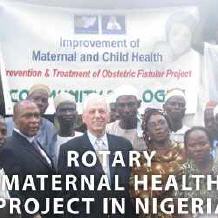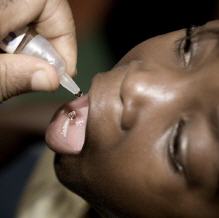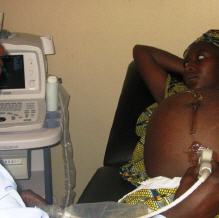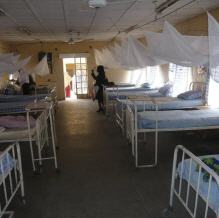Quality Assurance
Quality Assurance in Obstetrics to reduce maternal and fetal mortality (MDG 5 and 4)
Maternal and fetal mortality are significant indicators for the quality of care in obstetrics. Within the Rotary ‘Maternal Health Project’ in Northern Nigeria an evidence-based, effective model has been developed to improve obstetric services and lower the maternal mortality ratio (MMR) and the fetal mortality ratio (FMR). The following methodology will give you an overview about the prerequisites and functionality of the developed system of quality assurance. This model is suitable for replication and can be applied to health care centers in other countries with high maternal and fetal mortality ratios. It has proven to be a successful contribution to the achievement of the UN Millennium Development Goals 4 and 5. If you are interested in using our model in your country, please contact us for more information and details of implementation.
The principles of quality assurance
The system of quality assurance in a hospital is based on three parameters:
1. quality of structure,
2. quality of process,
3. quality of outcome.
All three parameters are interdependent and closely connected. Quality of structure comprises the condition of the hospital building: water supply, power supply, hygienic conditions, number of staff and the equipment available. The quality of process is predominantly dependent on a sufficient structure, but also on trained and well functioning experienced health personnel and on professional performance. This can be achieved by a continuing evaluation of the results and by benchmarking. The necessary interventions will lead to a spiral of reduction in maternal and fetal morbidity and mortality and consequently to an improvement of the quality of outcome.
Prerequisites – qualified staff and suitable health care centers
Since this model is about the improvement of quality in obstetrics, experienced gynecologists are needed to oversee the process of implementation, give advice on medicinal practices and constantly review the implemented measures and their results. The system of quality assurance is based on a constant data collection and analysis, which makes it necessary to have trained health staff, e.g. experienced midwives, to collect the data and control their proper documentation. For the analysis of the data a statistician is needed who examines the collected data, checks it for plausibility, analyses and processes it for the review process. In agreement with the (local) government suitable hospitals/health care centers need to be chosen, preferably in rural areas as experience has shown that remote hospitals often have larger deficits in obstetric care. It is also important that the management boards of the selected hospitals fully support the measures of quality assurance and therefore need to be incorporated in the selection process.
Data collection – obstetric data, status of infrastructure, hygiene conditions
All participating hospitals are given a code number to guarantee confidentiality within the review and analyzing process that follows the data collection; when getting the results of the data collection, each hospital is able to identify itself but not the others. This encourages honest criticism and improves the results in the benchmarking process. A uniform maternity record book should be used in all participating hospitals, retrieving and documenting 16 obstetric parameters for each delivery, such as age of patient, gestational age, mode of delivery, complications at delivery and/or postpartum, birth weight and Apgar score of the baby. These data are summarized in a monthly form, giving the total figures about e.g. prenatal clinic attendance, deliveries, cesarean deliveries, cases of eclampsia, and total maternal and fetal deaths. These monthly forms are collected, monitored and check by the doctors and midwives of the project team.
In addition to the collection and monitoring of obstetrical data it is also important to evaluate and document the status of infrastructure and hygienic conditions in each hospital. This is done by a structured questionnaire, in which neutral investigators award points for infrastructure (e.g. equipment) and hygiene using score criteria. Five units are evaluated: operating theater, delivery room, neonatal unit, delivery ward/prenatal clinic, and general conditions of the hospital – with a total of 37 score criteria rated from 1 (excellent) to 6 (very poor). According to the points given for each unit, the total score for general infrastructure/equipment and hygiene conditions for each hospital is determined. With this score a comprehensive impression of each hospital can be obtained and the relationship between maternal/fetal mortality and the score for each hospital can be identified. Knowing the deficits in quality of structure, they can be eliminated by providing necessary equipment and improving hygienic conditions, e.g. by training health personnel.
Improving the quality of process
Major direct causes of maternal mortality and morbidity are eclampsia, hemorrhages, high blood pressure and obstructed labor. They can easily be avoided and/or treated with a sound knowledge in emergency obstetric care. Therefore, the training of doctors, midwives and ward nurses in the obstetrical departments is an important part within the system of quality assurance. Health personnel should be trained in the use of magnesium sulfate for managing eclampsia and the treatment of postpartum hemorrhage (PPH), including the use of anti-shock garments. The scope of training certainly varies in different countries and should be adjusted to the individual needs/problems in each country. The improvement of the quality of process in obstetrics can also be extended to other areas of concern e.g. by measures for preventing mother-to-child transmission (PMTCT) of HIV.
The circle of quality assurance – analyzing data, benchmarking, setting new standards
It is advisable to collaborate with a department of obstetrics and gynecology in a Teaching Hospital within the project area and promote the establishment of an institute for quality assurance at this department, overseeing the data collection and closely collaborating with the statistician. The collected data from the participating hospitals is collated and analyzed by the statistician who then feeds back the anonymous results to the hospitals and prepares semiannual reports, showing the changes and improvements in the quality of care as well as remaining problems. These reports form the basis for the discussion at semiannual review meetings. Representatives of all participating hospitals, e.g. a head doctor of the obstetrical department and a midwife, should attend the review meetings. At these meetings major problems observed from the data collection and at hospital visits are addressed and tried to eliminate by developing and setting new standards, improving the quality of care in the obstetric departments. After the incorporation of new/improved standards, the quality circle (Fig. 2) starts again with the monitoring of practices in order to identify occurring problems, setting new standards if needed, comparing practice with these standards, and then analyzing the effect of the practice on outcome (maternal and fetal mortality).
In the Rotary Maternal Health Project the implementation of quality assurance in obstetrics was part of a comprehensive approach, including an awareness and advocacy campaign with entertainment education radio serials and community dialogues, a close collaboration with traditional, religious and political leaders as well as stakeholders (e.g. governments, NGOs), the improvement of water and energy supply, the treatment of patients suffering from obstetric fistula (VVF) and their rehabilitation with vocational training and micro credits.
References:
Hadiza Galadanci, Wolfgang Künzel, Oladapo Shittu, Robert Zinser , Manfred Gruhl , Stefanie Adams
Obstetric quality assurance to reduce maternal and fetal mortality in Kano and
Kaduna State hospitals in Nigeria
International Journal of Gynecology and Obstetrics 114 (2011) 23–28














